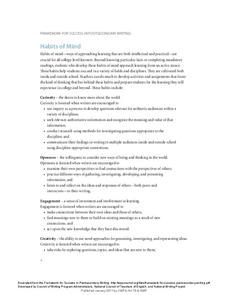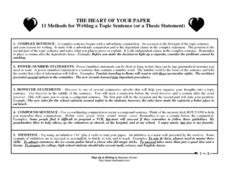San José State University
Organizational Patterns for the Comparison/Contrast Essay
Organization is key in essay writing. The two organizational charts included in this resource model the block approach and the point-by-point approach to organizing a compare and contrast style essay. After examining the charts, writers...
MENSA Education & Research Foundation
The Writer’s Toolbox: What You Need to Master the Craft
Strengthen your high schoolers' writing with a series of steps for writing successfully. With sections on organizing an essay, choosing a topic, crafting a thesis statement, and revising a draft, the lesson encourages your class to...
Nosapo
Writing Prompt: Write About a Photo
Practice descriptive writing with a prompt that includes a photograph. Writers craft the whole story of the single second caught in a photo using the provided questions to prompt their imaginations.
Curated OER
Revising vs. Editing
Are your young writers unsure of what to look for when asked to edit a draft of writing? Direct them to this simple and attractive printable, which uses two acronyms—ARMS (add, remove, move, substitute) and CUPS capitalize, usage,...
Scholastic
Leads in Narrative Writing
The beginning, a very good place to start, is also a very difficult thing to craft. Provide your writers with this handout that identifies, and provides examples of, six different types of narrative leads.
J. Hines, Ed Prgms Intern
Comma Usage
Sometimes it feels like young writers just place commas as they please! Ensure that your pupils uses these important punctuation marks properly by requiring them to study the information here and complete the grammar exercise....
San José State University
Parallelism
What is parallelism? Novice writers learn about parallelism and practice balancing 10 sentences for better syntax and parallel structure. A clear, straightforward worksheet with answers included.
Oregon Department of Education
Habits of Mind
There is more than one way to approach a problem. Explore the habits of mind as they relate to the methods of approaching learning, and to how young writers can develop success once they learn to foster each skill.
San Diego Unified School District
On-Demand Persuasive Writing Samples
Young writers complete a timed persuasive writing assignment in which they argue for a club they would like to see established at school, and are then provided with real student samples of responses.
San José State University
The Quotation Mark
Review where quotation marks belong and what they are used to indicate. From direct speech to in-text citations, young writers will find this worksheet quite useful. Several exercises at the bottom, along with a key, give learners...
San José State University
Essay Exams: Common Question Types
Novice writers often struggle to determine what style of essay to write when given a prompt. This instructional activity helps to identify an appropriate form based on the language of the question. For example, key words like prove or...
Curated OER
The Heart of Your Paper: 11 Methods for Writing a Topic Sentence (or a Thesis Statement)
Help your young writers produce high-quality topic and thesis statements that go beyond basic wording and really illustrate complex ideas and critical thinking skills. From however and compound sentence statements to using rhetorical...
Anchorage School District
Hints for Writing a Conclusion
Writing the conclusion of an essay can often seem like a superfluous or daunting task. Support your young writers in understanding the various types and purposes of a conclusion paragraph, such as summarizing key points of a paper or...
Curated OER
Thesis Statement + Projected Plan = Introduction
Set up your writers for writing strong introductions with a formula for putting together supported thesis statements. This reference page breaks the process down and provides an example of how to compose a thesis statement, develop a...
Model Citizen Publications
How To Write a Paragraph
Instructing learners on how to craft a good paragraph, a skill required of all writers, is the focus of a 23-page packet that includes directions, graphic organizers, exercises, and worksheets for guided practice.
IPDAE
Themes in Short Stories
"What is the theme of this story?" The very question can spark fear in the minds of readers and incinerate confidence. Here you will discover an exercise that shows how writers use the tools of setting, plot, conflict, and...
Chomp Chomp
The Subordinate Clause
After Amy sneezed all over the tuna salad. So what happened? That is the question readers ask when faced with a subordinate clause unattached to a main clause. And this information sheet shows writers how to combine subordinate clauses...
Library of Congress
Determining Point of View: Paul Revere and the Boston Massacre
If you're teaching point of view, this is the lesson for you! First, decipher the writer's point of view from a primary resource, then compare and contrast the primary source with a secondary source to explore the Paul Revere's engraving...
Vanier College
Analyzing Short Stories/Novels
Good questions can help focus readers' attention on the elements writers use to add depth to their stories. The questions on this worksheet do just that and encourage readers to think critically about a story and author's purpose.
Brooklyn College
Irony, Sarcasm, Satire
Irony, the discrepancy between what is expected and what occurs, is the focus of a reference sheet that provides young writers with models of this literary device.
San José State University
Essay Outline Template
Inspire essay organization with this handout and exercise about outlining. Writers read through a brief outline model and then practice writing their own outline by completing a second model. Scholars not only complete the outline, they...
San José State University
Old Information Before New Information
Help your writers streamline their sentence structure with this handout. This resource provides information about sentence organization including definitions and models of the active voice and the passive voice. In addition to reading...
Curated OER
When Finished With Writing Check For
There are no tasks attached to this link. However, this resource could be used to help young writers remember what to look for as they edit their work. They check for capitals, understanding, punctuation, and spelling. As they check...
San José State University
Prepositions of Time
On, at, in, since, for, during, within... what do all of these words have in common? They are prepositions and they are all prepositions that are included on this hand-out. This handout breaks down prepositions used when talking about...
Other popular searches
- Freedom Writers
- Writers Workshop
- Writers Notebook
- Writers Craft
- Freedom Writers Movie
- Writers Craft Story Starters
- Natural History Writers
- Writer's Workshop
- Writers Block
- Freedom Writers Diary
- Women Writers
- Beat Writers

























